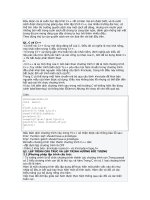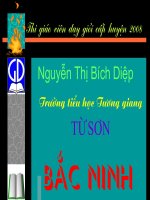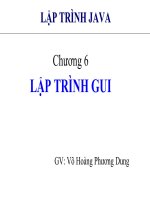INPUT, OUTPUT STREAM (lập TRÌNH MẠNG cơ bản SLIDE)
Bạn đang xem bản rút gọn của tài liệu. Xem và tải ngay bản đầy đủ của tài liệu tại đây (1.71 MB, 113 trang )
BASIC NETWORK PROGRAMMING
MODULE 1
INPUT / OUTPUT STREAM
1
Goals
become familiar with the concept of an
I/O stream
understand the difference between binary
files and text files
learn how to save data in a file
learn how to read data from a file
Understand the File/Data Format
Khoa CNTT – ĐH Nông Lâm TP. HCM 08/2010
2/112
Outline
Stream concepts
Input Streams
Output Streams
Reader
Writer
Object Serialization
Object Input Stream
Object Output Stream
Khoa CNTT – ĐH Nông Lâm TP. HCM 08/2010
3/112
MODULE 1
INPUT / OUTPUT STREAM
STREAM CONCEPTS
4
Stream concepts
File
information
Program
Memory
Network
Program
Data exchange
Data exchange type: Character, Object,
voice, picture, audio, video...
Khoa CNTT – ĐH Nông Lâm TP. HCM 08/2010
5/112
Stream concepts
An I/O Stream represents an input source or an output
destination. A stream can represent many different kinds of
sources and destinations, including disk files, devices, other
programs, and memory arrays.
Streams support many different kinds of data, including
simple bytes, primitive data types, localized characters, and
objects. Some streams simply pass on data, others
manipulate and transform the data in useful ways.
Reading information into a progra
Writing information from a program
Khoa CNTT – ĐH Nông Lâm TP. HCM 08/2010
6/112
Stream concepts
Byte-level communication is represented in Java
by data streams, which are conduits through
which information—bytes of data—is sent and
received
011001
1
011001
1
When designing a system, the correct stream
must be selected
Streams may be chained together, to provide
an easier and more manageable interface.
a
011001
1
Khoa CNTT – ĐH Nông Lâm TP. HCM 08/2010
7/112
Stream concepts
Stream: an object that either delivers data to its
destination (screen, file, etc.) or that takes data from a
source (keyboard, file, etc.)
Input stream: a stream that provides input to a program
System.in is an input stream
Output stream: a stream that accepts output from a
program
it acts as a buffer between the data source and
destination
System.out is an output stream
A stream connects a program to an I/O object
System.out connects a program to the screen
System.in connects a program to the keyboard
Khoa CNTT – ĐH Nông Lâm TP. HCM 08/2010
8/112
Stream concepts
Basic Stream Operation:
open stream
close stream
read
write
Seek
Basic Stream Classification:
Input stream: support reading functions
Output stream: support writing functions
Filter stream: A filter stream is constructed on
another stream (the underlying stream). Some
streams buffer the data, some count data as it
goes by, and others convert data to another form
Khoa CNTT – ĐH Nông Lâm TP. HCM 08/2010
9/112
Input & Output Stream
Reading information into a program
Writing information out of a program
Khoa CNTT – ĐH Nông Lâm TP. HCM 08/2010
10/112
Reading and Writing Algorithm for Data
open input stream
while (more information){
read information
process information
}
close input stream
Writing into OS
Reading from IS
open output stream
while (more information){
get information from ...
write information
}
close output stream
Khoa CNTT – ĐH Nông Lâm TP. HCM 08/2010
11/112
java.io package
The java.io package contains a collection of stream classes that
support these algorithms for reading and writing. The stream
classes are divided into two class hierarchies, based on the data
type (either characters or bytes) on which they operate :
Byte Streams : input/output stream
Character Streams : reader/writer (unicode)
Khoa CNTT – ĐH Nông Lâm TP. HCM 08/2010
12/112
Binary Versus Text Files
All data and programs are ultimately just zeros and ones
each digit can have one of two values, hence binary
bit is one binary digit
byte is a group of eight bits
Text files: the bits represent printable characters
one byte per character for ASCII, the most common code
for example, Java source files are text files
so is any file created with a "text editor"
Binary files: the bits represent other types of encoded
information, such as executable instructions or numeric data
these files are easily read by the computer but not humans
they are not "printable" files
actually, you can print them, but they will be
unintelligible
"printable" means "easily readable by humans when
printed"
Khoa CNTT – ĐH Nông Lâm TP. HCM 08/2010
13/112
Text Versus Binary Files
Text files are more readable by humans
Binary files are more efficient
computers read and write binary files more easily than
text
Java binary files are portable
they can be used by Java on different machines
Reading and writing binary files is normally done by a
program
text files are used only to communicate with humans
Java Text Files
Source files
Occasionally input files
Occasionally output files
Java Binary Files
Executable files (created
by compiling source files)
Usually input files
Usually output files
Khoa CNTT – ĐH Nông Lâm TP. HCM 08/2010
14/112
Byte stream: input/output stream
Programs use byte streams to perform input and
output of 8-bit bytes. All byte stream classes are
descended from InputStream and OutputStream
(Abstract class)
InputStream and OutputStream provide the API
and partial implementation for input streams
(streams that read 8-bit bytes) and output
streams (streams that write 8-bit bytes).
These streams are typically used to read
and write binary data such as images and
sounds.
Khoa CNTT – ĐH Nông Lâm TP. HCM 08/2010
15/112
input stream
Khoa CNTT – ĐH Nông Lâm TP. HCM 08/2010
16/112
output stream
Khoa CNTT – ĐH Nông Lâm TP. HCM 08/2010
17/112
Character stream: reader/writer
The Java platform stores character values using Unicode
conventions. Character stream I/O automatically translates this
internal format to and from the local character set.
For most applications, I/O with character streams is no more
complicated than I/O with byte streams. Input and output done with
stream classes automatically translates to and from the local
character set. A program that uses character streams in place of byte
streams automatically adapts to the local character set, and is ready
for internationalization — all without extra effort by the programmer
Khoa CNTT – ĐH Nông Lâm TP. HCM 08/2010
18/112
Writer
Khoa CNTT – ĐH Nông Lâm TP. HCM 08/2010
19/112
Stream overview
Memory
I/O Streams
CharArrayReader
CharArrayWriter
ByteArrayInputStream
ByteArrayOutput
-Stream
StringReader
StringWriter
StringBufferInputStream
Mô tả khái quát
Đọc/ghi từ/vào bộ nhớ.
Tạo stream từ một mảng, tiếp theo dùng
các phương thức đọc/ghi để đọc/ghi
từ/vào mảng.
Tác vụ đọc sẽ lấy dữ liệu từ mảng
Tác vụ ghi sẽ ghi ra mảng
StringReader để đọc các ký tự từ
một String trong bộ nhớ.
StringWriter để ghi vào String.
StringBufferInputStream tương
tự như StringReader. Sự khác biệt
chỉ là StringBufferInputStream
đọc các bytes từ một đối tượng
StringBuffer
Khoa CNTT – ĐH Nông Lâm TP. HCM 08/2010
20/112
Stream overview
PipedReader
PipedWriter
PipedInputStream
Pipe PipedOutputStream
Hiện thực các thành phần input
và output của một pipe. Pipes
được dùng như một kênh truyền,
nối output của một thread vào
input của một thread khác.
FileReader
FileWriter
File FileInputStream
FileOutputStream
Được gọi là các file streams. File
streams dùng để đọc/ghi từ/vào
file trên file system.
Nối
SequenceInputStream
(concatenation)
Nối nhiều input streams thành
một input stream.
Khoa CNTT – ĐH Nông Lâm TP. HCM 08/2010
21/112
Stream overview
Object
Serialization
ObjectInputStream
ObjectOutputStream
Dùng khi cần lưu trữ, khơi
phục, hoặc truyền tồn bộ
đối tượng.
Chuyển
đổi dạng
dữ liệu
DataInputStream
(Data
DataOutputStream
Conversion)
Thuận tiện khi cần đọc/ghi
các kiểu dữ liệu cơ bản
(primitive data types) như
int, double, ...
LineNumberReader
Counting LineNumberInputStream
Theo dõi số hàng trong khi
đọc
Khoa CNTT – ĐH Nông Lâm TP. HCM 08/2010
22/112
Stream overview
PrintWriter
Printing
PrintStream
Rất thuận tiện khi cần kết
xuất, dễ đọc với người.
System.out là một đối
tượng thuộc lớp
PrintStream.
BufferedReader
BufferedWriter
Đệm
bufferedInput(BufferStream
ing)
BufferedOutputStream
Đệm dữ liệu trong các thao
tác đọc/ghi.
Đệm dữ liệu cải thiện tốc độ
đọc ghi vì giảm số lần truy
xuất thiết bị.
FilterReader
Lọc dữ liệu FilterWriter
(Filtering) FilterInputStream
FilterOutputStream
Các lớp abstract này định
nghĩa các giao tiếp cho các
filter streams lọc dữ liệu
trong khi đọc/ghi.
Khoa CNTT – ĐH Nông Lâm TP. HCM 08/2010
23/112
Stream overview
InputStreamReader
OutputStreamWriter
Chuyển đổi byte
ký tự
(Converting between Bytes and Characters)
Cặp reader/writer này là cầu nối giữa các byte
streams và character streams.
Một InputStreamReader đọc các bytes từ một
InputStream và chuyển các bytes đó thành các
ký tự.
Một OutputStreamWriter chuyển các ký tự
sang các bytes, và ghi các bytes đó vào một
OutputStream.
Q trình chuyển đổi sẽ sử dụng bộ mã mặc định
nếu không được chỉ định rõ.
Gọi
System.getProperty("file.encoding")
để lấy về tên bộ mã mặc định.
Khoa CNTT – ĐH Nông Lâm TP. HCM 08/2010
24/112
Stream sumary
InputStream, OutputStream, Reader và
Writer là các lớp abstract:
Các lớp input stream được mở rộng từ lớp
InputStream
Các lớp reader được mở rộng từ lớp Reader
Các lớp output stream được mở rộng từ lớp
OutputStream
Các lớp writer được mở rộng từ lớp Writer
2 lớp InputStream và Reader cung cấp những
phương thức read tương đối giống nhau.
2 lớp OutputStream và Writer cung cấp những
phương thức write tương đối giống nhau.
Khoa CNTT – ĐH Nông Lâm TP. HCM 08/2010
25/112









